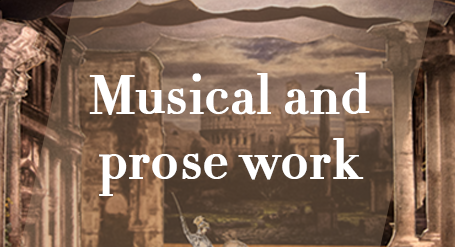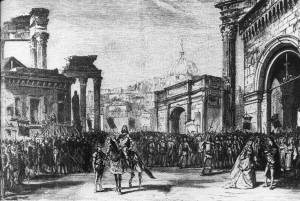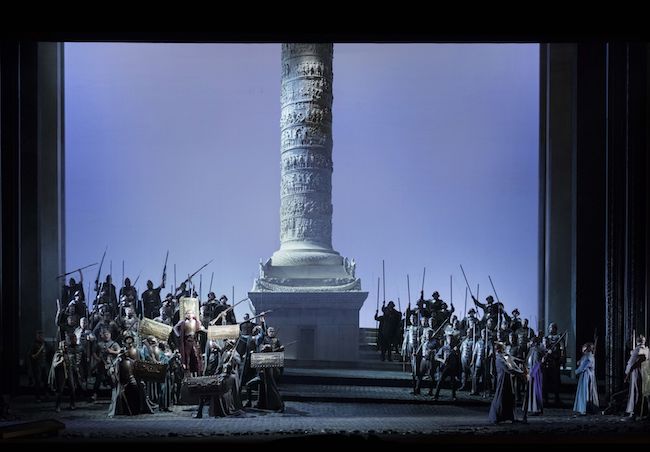
The musical work of Richard Wagner is composed of operas or “musical dramas” ranging from “Fairies” (Die Feen) to “Parsifal”. A detailed presentation of each of these major works is associated here with a set of thematic articles, placing them not only in the context of his personal life but also in his social, economic and cultural context. This section also includes all the musical works (excluding opera) and his literary work.
Rienzi, The Last of the Tribunes, WWV49
Rienzi, der letzte der Tribunen, WWV49
Grand Opera in five acts
Libretto and music by Richard Wagner,
after Edward Bulwer-Lytton’s novel Rienzi, the Last of the Roman Tribunes (1835)
Premiere :
20th october 1842, Hofoper Dresden, led by Carl Gottlieb Reissiger
Cast :
COLA RIENZI, The Pope’s notary (tenor)
IRENE, his sister (soprano)
STEFFANO COLONNA, head of the House of Colonna (bass)
ADRIANO, his son (soprano)
PAOLO ORSINI, head of the House of Orsini (bass)
Cardinal ORVIETO (became RAIMONDO in 1842), Papal Legate (bass)
BARONCELLI, a Roman citizen (tenor)
CECCO DEL VECCHIO, a Roman citizen (bass)
A Messenger of Peace (soprano)
A Herald (tenor)
Ambassador of Milan (bass)
Ambassadors of the lombard cities (tenor and bass)
Ambassador of Naples (tenor)
Ambassadors of Bohemia and Bavaria (bass)
Roman nobles and guardsmen, followers of the Colonna and Orsini families, priests and monks of all religious orders, senators, Roman men and women, messengers of peace, Roman soldiers (chorus)
Characters of the 2nd act pantomime :
Brutus, Collatinus, Tarquinius, Lucretia, Virginia, Peace (later, the Goddess of Peace), Lucretia’s virgins, young Romans, Tarquinius’ soldiers, Romans, knights
The action takes place in Rome, in the middle of the 14th century.
Duration : 3 hrs. 45
![]() Rienzi, der letzte der Tribunen, WWV49 (Rienzi, the Last of the Tribunes) is Wagner’s third completed opera and what is generally considered as the last of his youth operas. The subject is based on the story of Cola di Rienzo, more precisely on the historical novel by Edward Bulwer-Lytton, and takes place in medieval Rome.
Rienzi, der letzte der Tribunen, WWV49 (Rienzi, the Last of the Tribunes) is Wagner’s third completed opera and what is generally considered as the last of his youth operas. The subject is based on the story of Cola di Rienzo, more precisely on the historical novel by Edward Bulwer-Lytton, and takes place in medieval Rome.
 Composed between April 1839 and October 1840, Rienzi was first brought to the stage in Dresden on 20 October, 1842, almost at the same time as The Flying Dutchman. While the former was a triumph, the latter, undoubtedly ordered in a hurry by the authorities of the Court of the Saxon Kingdom after the immense success of Rienzi, was not met with the same enthusiasm from the public or the critics.
Composed between April 1839 and October 1840, Rienzi was first brought to the stage in Dresden on 20 October, 1842, almost at the same time as The Flying Dutchman. While the former was a triumph, the latter, undoubtedly ordered in a hurry by the authorities of the Court of the Saxon Kingdom after the immense success of Rienzi, was not met with the same enthusiasm from the public or the critics.
After dabbling in the German romantic style (The Fairies), then the Italian one (The Ban on Love), Wagner wanted to conquer Paris. He thus created a work along the same lines as the “grand opera à la française” with the will – already – to surpass it: a historical subject developed in five acts with a ballet in the third, large scenes allowing the deployment of vast choral parts, grandiose decorations animated by machineries with spectacular effects and no less than twelve soloists! But the work originally created for Paris, and thus conceived on a libretto in French – nicknamed furthermore by Hans von Bülowas the best opera in… Meyerbeer! – took a quarter of a century to reach the capital.
The true story of Nicola Lorenzo, known as Cola di Rienzo (1313-1354), started in a heroic way. He rose up against corruption in Rome, and this son of a baker pushed the people to rise up against the dominant clans. He got acclaimed as a new tribune, but his megalomania brought him enemies in high places, and he ended up murdered. Wagner takes up the outlines of Bulwer’s novel, but idealizes the hero (read more…)
If you wish to share further information about this article, please feel free to contact us !
